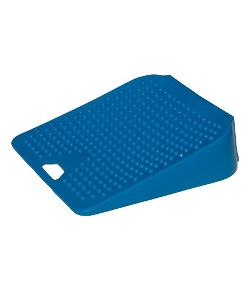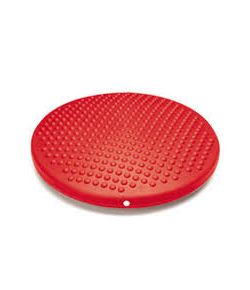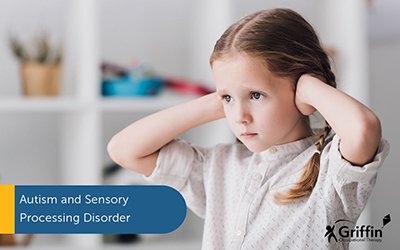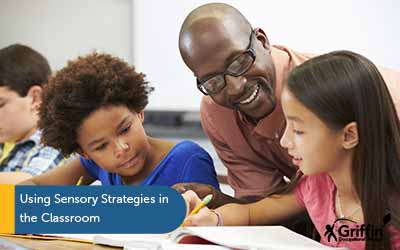There’s a wobble cushion in my classroom!
You will often see wobble cushions or sensory cushions in classrooms at school. One example is the sensory wedge-shaped cushion called a Move and Sit cushion (Move n Sit). Another is the circular version called a Disc-o-Sit. Both are sensory cushions designed to be filled with air and sat on. A wobble cushion for the classroom can be one of the first things that is tried for a child with special education needs or poor attention in class. However, sometimes this might not be the most appropriate recommendation. And, sometimes the wobble cushions are being used incorrectly.
In this post, occupational therapist Kim Griffin explains what these sensory cushions are designed for and share some tips on how to use a wobble cushion correctly.

There’s a wobble cushion in my classroom!
You will often see wobble cushions or sensory cushions in classrooms at school. One example is the sensory wedge-shaped cushion called a Move and Sit cushion (Move n Sit). Another is the circular version called a Disc-o-Sit. Both are sensory cushions designed to be filled with air and sat on. A wobble cushion for the classroom can be one of the first things that is tried for a child with special education needs or poor attention in class. However, sometimes this might not be the most appropriate recommendation. And, sometimes the wobble cushions are being used incorrectly.
In this post, occupational therapist Kim Griffin explains what these sensory cushions are designed for and share some tips on how to use a wobble cushion correctly.
What are wobble cushions or air-filled cushions designed for?
These sensory cushions, regardless of shape, are all designed to be filled with air. This creates a moving surface for the child to sit on. The idea is that this movement (or vestibular input) will help to keep the child more alert. The aim of the sensory wobble cushion is to help the child’s (or adult’s) attention and focus. I discuss this concept further on our sensory seating page. You should expect a student to still move about on the cushion, however, they should remain in their place and will not rock back in their chair.
Which children benefit most from a sensory cushion?
Wobble cushions can be suitable for children with ADHD or autism. They can also help children that are constantly moving about, fidgeting and maybe rocking in their chair. It is thought that these children are using their movement to help to stay alert and regulate. Within the sensory processing disorder model these children would be called movement ‘sensory seekers’. The cushion can provide a more appropriate and less distracting way for them to receive movement whilst sitting in their chair. A cushion could also be helpful for a child who is slumped in their chair and appears to have low energy. This is because it might help to ‘wake up’ their vestibular system and help with their alertness.
Bonus tip: Make sure you check seat height first!
Before suggesting a wobble cushion it is important to check that the child is not fidgeting because their feet can’t touch the floor. If the child’s chair is too high for them, they will find sitting still in their chair very difficult. The cushion will make them even higher and even more unstable! Also children with poor core stability and balance might find the cushions very difficult to sit on. This is because the cushion is unstable and therefore harder to stay seated on compared to a harder surface.

Theo – My wobble cushion helps me focus
Theo finds it harder to sit still than his peers. Movement helps his body to stay alert. His teacher provided a wobble cushion at the start of term. Theo preferred the round cushion as it was more comfortable for him.
“I like sitting on the cushion, it stops me from rocking in my chair and helps me to listen to my teacher.”
Kim’s ten tips for using wobble cushions
Tip 1 – Monitor wobble cushions in the classroom
Make sure you’re monitoring the child’s response to the cushion. You need to be sure that the child’s attention and/or focus is improving once they start using the air-filled sensory cushion. There is no value in having a child sit on a cushion if it is not helping. I discuss behaviours that you can look out for on my sensory seating page.
Tip 2 – Inflate it!
You must always inflate the wobble cushion! I know this seems like a rudimentary comment but I have been into schools before where well-meaning assistants have taken out all of the stoppers because children were playing with them. I have children report that their stopper was missing and they were still sitting on the cushion.
Without the air, the child may as well just be sitting on a piece of plastic. The sensory cushions typically come deflated and need a bit of air blown into them before they are used. They will also need checking from time to time. Most cushions have a valve that comes out, but some need to be inflated with a ball pump and needle. This just depends on the brand and design. The Move and Sit cushion and Disc-o-sit both have valves that come out.
How much should I inflate my wobble cushion?
The movement cushion should have enough air in it so that it is unstable when the child sits on it. If it is too deflated, the child will touch the bottom of the cushion when they sit down. If it is over inflated, the cushion will rock side to side like a sea-saw without a student sitting on it.
The base of the cushion should be stable, but when a student sits on the wobble cushion in the classroom it should move. The student should be able to move around gently as they are seated. The amount of air will also change depending on the student’s size as heavier students will need slightly more air than lighter students.
Kim shows you how to inflate a sensory wobble cushion in this video. It’s important to make sure there is the correct amount of air in the sensory cushion.
Tip 3 – Ensure the child is sitting on the sensory cushion
The child must be fully seated on the movement cushion! Again, a simple thing to check for but I have frequently seen children in schools perching on the front of their chair to avoid sitting on the cushion. This often happens with the wedge style movement cushions (e.g. Move and Sit). If the child is perching at the front of their chair with only a little bit of their body touching the cushion, then they are not going to get any benefit from it. The child should have their body back in the chair so that they are sat fully on the wobble cushion in the classroom. Sometimes, children sit forward and off the cushion because they don’t like the movement it provides, in this case it should be removed!
Tip 4 – Check the size of the wobble cushions
Make sure the sensory cushion is the right size for the child. Typically wobble cushions for students come in two sizes: child and adult. The child’s entire bottom and the top of their thighs should be on the cushion. Their thighs should not be bulging over the sides. Older and or bigger students may need an adult size (I have worked with one eight year old who required an adult-sized cushion). Don’t just assume a child will need a child’s size. Match the cushion size to the individual student’s needs.
Tip 5 – Do the child’s feet still touch the ground?
You must make sure the child’s feet can still touch the ground when they are sitting on the wobble cushion in the classroom. The cushion, especially the Move and Sit wedge style, will make the child sit higher in their seat. The movement also makes them more unstable in their seat. If their feet are not touching the ground, they may fall out of their chair. They may also be more disruptive with their movement to the other students in the class.

Tip 6 – Flip It!
If the child doesn’t like the lumps on the cushion, it is OK to flip it. Some children who have touch sensitivity find the texture of the cushions uncomfortable. It still works used upside down (as long as it’s inflated!). Please note, this won’t be a solution for child who dislikes the movement the cushion provides, it will only support the children who dislike the feel of the texture on the cushion.
Tip 7 – A suggestion for circle shaped cushion heights
If using a circle shaped cushion, the flatter ones (max 2.5cm / 1” high when deflated) are, in my opinion, best. Some of the thicker cushions have a smaller diameter to sit on, which makes them quite unstable. Some are also just unstable because the height reduces the child’s ability to touch the ground with their feet.
Tip 8 – Monitor use when using as classroom floor cushion
Wobble cushions often don’t work well on the classroom floor. I often see them recommended for, or used on, the floor. However, they are tricky to balance on when on the floor, especially for longer periods! Often the child is either falling about into their peers, or focusing so hard on staying balanced that they are no longer listening to the teacher. Each child is different, but if you’re using a wobble cushion on the floor make sure it’s helping.
The other safety risk when they are on the floor is if they are left unattended. If the cushion is stepped or jumped on, it could easily cause an ankle injury. When cushions are used on the floor, it is important they are stored away as soon as the children stand up to avoid injuries.
If you need to mark out a place for the child to sit, because they can’t stay in their space, a carpet square or circle is a better choice. Also, consider introducing a movement break prior to carpet time to help alert the student. Instead of a cushion, a weighted lap pad might provide more helpful sensory input to the child to stay seated if they are fidgeting a lot. If it is decided that the air-filled cushion is the best option, it may be better for the child to sit on a chair on the cushion, instead of sitting on the floor.
Tip 9 – Do not use wobble cushions in the classroom together with weighted products
I would not recommend combining an air-filled cushion with any type of weighted products, especially weighted vests. The movement of the cushion makes the child more unstable. If they have any posture or tone issues, adding extra weight to their body will cause them to really struggle. There is also a likelihood that they could injure themselves, especially if they happen to fall off their chair.
Tip 10 – Have you tried to sit on one?
My final tip for you is to try out the wobble cushion yourself. It amazes me how many teachers and parents have never actually sat on the cushion that they are recommending. Do you like how it feels? Does it help your attention? Or do you find it uncomfortable? Or annoying? These are the types of reactions your students might have to the cushions!
Wobble cushions for the classroom are not going to work for everyone. However, for the students they help, they are a good resource. It is really important to ensure they are used and monitored correctly. I give some tips on how to do this in my article Sensory Seating – Tips for Choosing Sensory Cushions and Sensory Chairs.
Bicycle by Keagan Henman on Unsplash





